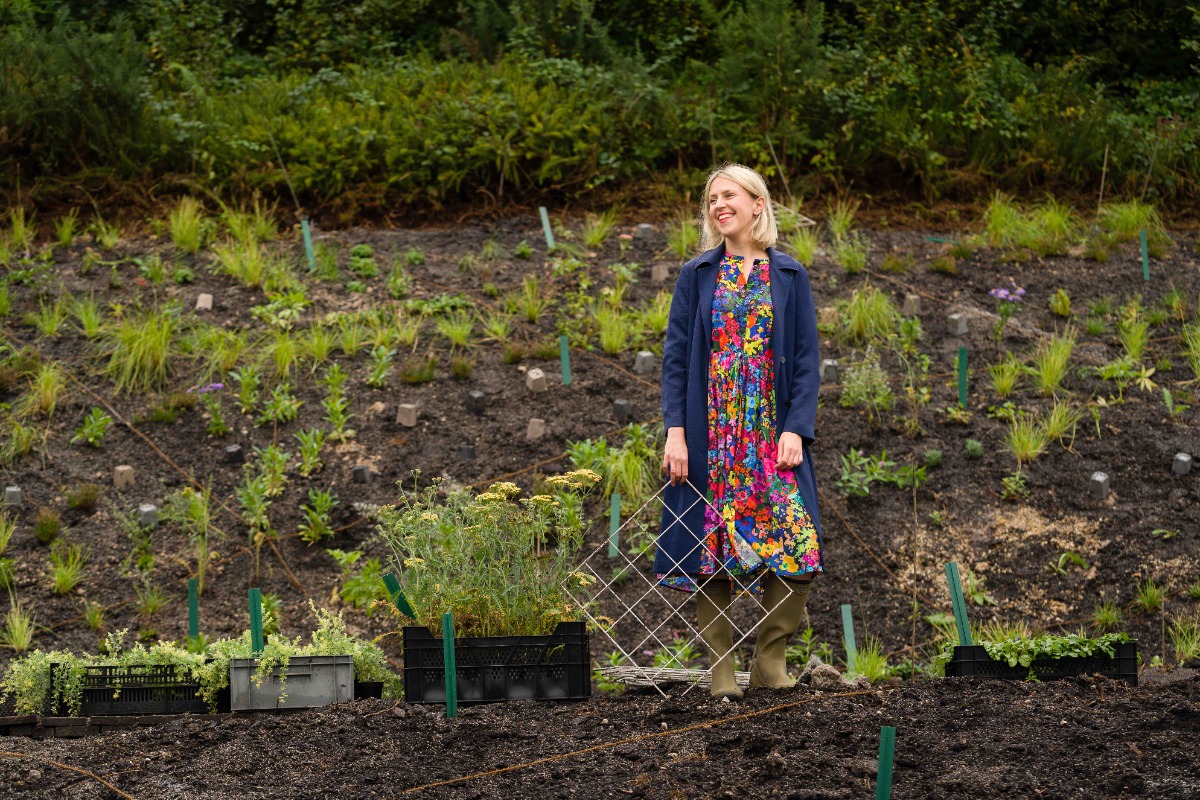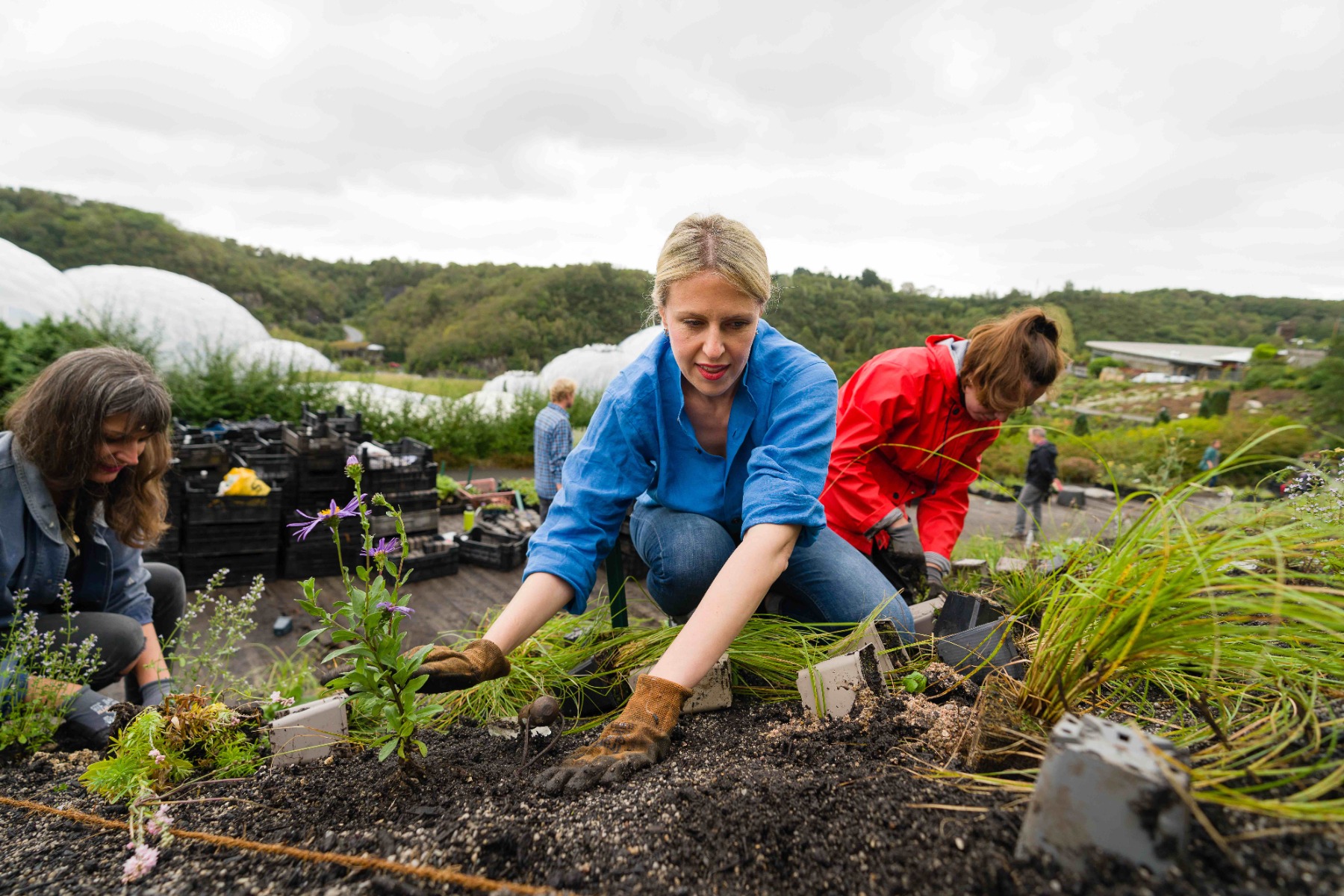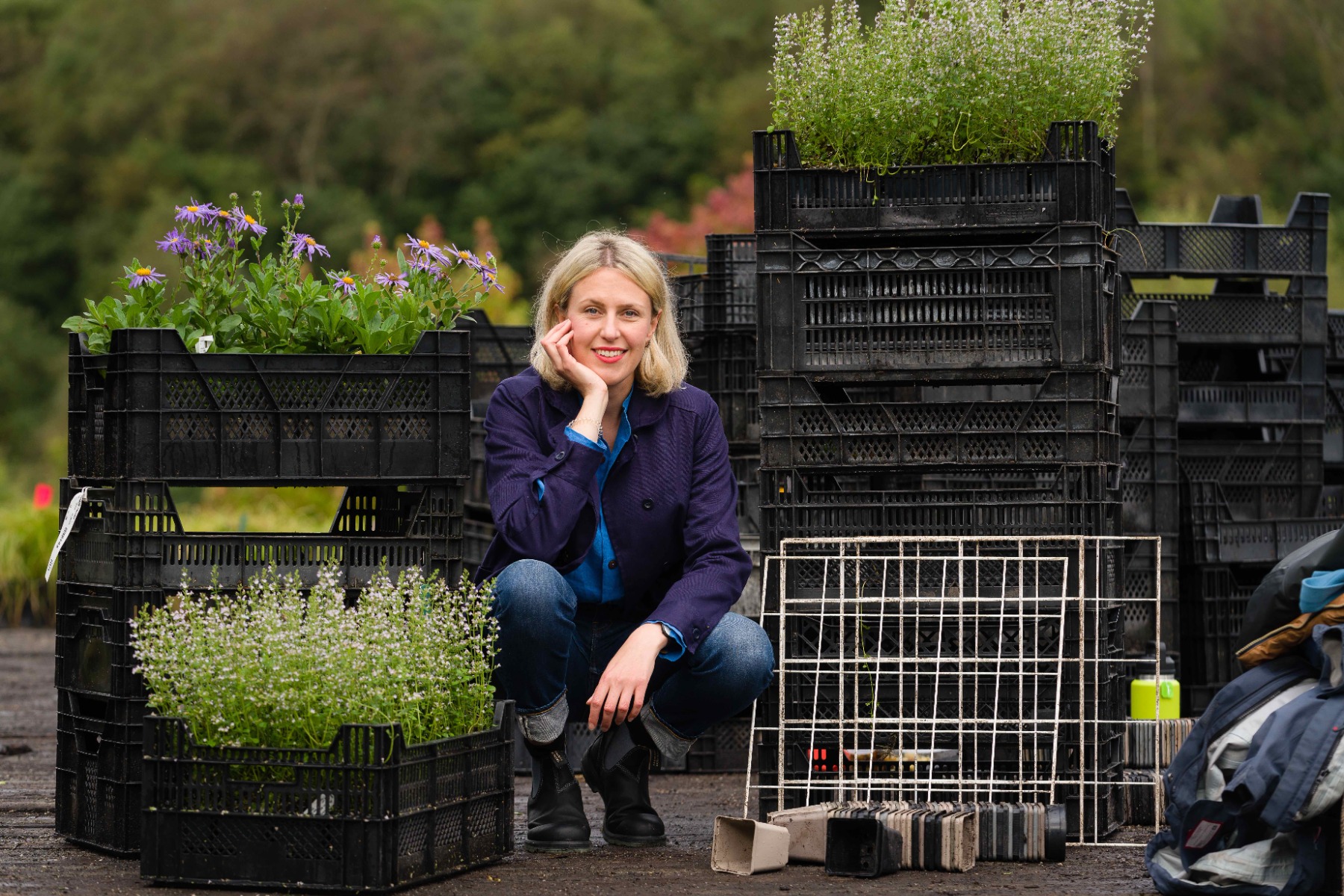
Pollinator Pathmaker. The largest ever climate positive artwork
Work begins planting living artworks across the globe, as artist Alexandra Daisy Ginsberg asks us to view the world through the eyes of a pollinator
Pollinator Pathmaker, a new permanent 55-metre-long living artwork by Alexandra Daisy Ginsberg that explores the vital role of pollinators, will be planted at the Eden Project, Cornwall, this Autumn.
‘I hope we can create the largest ever climate positive artwork together, by planting living artworks for pollinators around the world’, said Alexandra Daisy Ginsberg.
Horticulture Apprentices and Students assist with the planting of Pollinator Pathmaker. Photo: Steve Tanner. Courtesy: Eden Project
The artwork is part of the “Create a Buzz” programme at Eden Project, supported by the Garfield Weston Foundation, that seeks to communicate the story of the UK’s native pollinators: their vital role, their current plight and their restoration.
The work has been originally commissioned by the Eden Project and funded by Garfield Weston Foundation. Additional founding supporters are Gaia Art Foundation and collaborators Google Arts & Culture. Further ‘editioned’ gardens will then be sown across the UK and Europe, following the planting of the inaugural artwork in Cornwall.
Pollinator Pathmaker asks visitors to view the world in a different way; from the perspective of plants and pollinators, and to take part in an international cultural campaign to help save bees and other endangered species of pollinating insects ‒ the first of its kind. There has been a dramatic decline in pollinating insects in the last 40 years due to habitat loss, pesticides, invasive species, and climate change and the artwork is a call to take action against this.
Horticulture Apprentices and Students assist with the planting of Pollinator Pathmaker. Photo: Steve Tanner. Courtesy: Eden Project
The living artwork at the Eden Project will comprise a new garden, designed, planted and optimised for pollinators’ tastes, using a specially designed algorithm and specially curated palette of plants.
Green-fingered audiences can also be part of this unique artwork and create, plant and share their own garden and planting scheme, designed for bees and other insect pollinators, using the new website and algorithm at pollinator.art, an experiment developed in collaboration with the Google Arts and Culture Lab. It is hoped people will grow these in whatever space they have available - at home, fields, community gardens and more.
The website launches on 3 November 2021, coinciding with the United Nations Climate Change Conference. The Cornwall garden is anticipated to be in full bloom for both pollinators and human audiences to enjoy by June 2022.
Alexandra Daisy Ginsberg at Eden Project, Autumn 2021. Photo: Steve Tanner. Courtesy: Eden Project
Using the website, audiences can use the artwork’s custom algorithm to generate their own unique planting scheme of locally-appropriate plants for bees and other pollinators, as a call to action to plant your own pollinator garden. The algorithm will create a planting design to support the maximum pollinator species possible, using plants from a curated selection of plants chosen for their benefits to pollinators. Users can see a 3D visualization of their unique garden bloom on their screen, created from paintings of each plant by Ginsberg, who has carefully researched thousands of species.
The website has been developed by The Workers with visual identity by Studio Frith. On the website, participants can also watch their digital garden change over the year, as flowers for different pollinators emerge in an animated seasonal view. A soundscape composed by award-winning sound artist Nick Ryan accompanies the work and audiences can explore how a garden might look through the eyes of insects. Some of the plants included on the site include endangered plants such as the Echium pininana, which is a rare example of a plant which produces nectar across the whole day. Another included is the Cynara cardunculus, a type of artichoke, which is a valuable source of nectar for bumblebees. The Stachys byzantina meanwhile, is a magnet for wool carder bees in particular.
Horticulture Apprentices and Students assist with the planting of Pollinator Pathmaker. Photo: Steve Tanner. Courtesy: Eden Project
The first international partners to plant a garden will be Light Art Space, a Berlin-based art foundation in Spring 2022. Further ‘editioned’ gardens will be planted in 2022 -including in London in partnership with the Serpentine.
Further partners are invited to come forward and be part of the project, as with every new international editioned garden, a new palette of locally-appropriate, pollinator friendly plants is then added to pollinator.art.
In line with Ginsberg’s artistic practice, Pollinator Pathmaker uses technology to raise awareness of one of the greatest challenges facing the natural world. The commission also explores the story of the UK’s indigenous pollinators: their vital role, their current plight, and the plans and need for their conservation. Pollinator Pathmaker has been developed in collaboration with Eden’s expert network of horticulturists, scientists and consultants. This includes the National Wildflower Centre which is based at the Eden Project, Eden’s master beekeeper Rodger Dewhurst and pollination experts including Professor David Goulson and Marc Carlton. Machine-learning expert and string theory physicist, Dr Przemek Witaszczyk of Jagiellonian University, Kraków, worked with Ginsberg to develop the algorithms behind the planting programme.
The growing work will make a positive change for pollinators and for the climate. Together, these insects pollinate many of our food crops, help the plants in our gardens and countryside to reproduce and flourish, and are a vital part of our ecosystems. While the dangers facing honeybees are widely publicised, they are not the only pollinators. In the UK for instance, over 250 species of bee including 24 species of UK bumblebee, one native honey bee species and many species of solitary bee play acrucial role in pollination, alongside flies, beetles, wasps, moths and butterflies.
Alexandra Daisy Ginsberg at Eden Project, Autumn 2021. Photo: Steve Tanner. Courtesy: Eden Project
For Pollinator Pathmaker, Ginsberg was inspired by Eden’s core principles: encouraging a sense of connection, awe and wonder towards our natural world, and above all, giving us hope and agency to help protect it. Dr Alexandra Daisy Ginsberg commented: “I wanted to make an artwork for pollinators, not about them. Can the audience of an artwork be more-than-human, and how can art be useful in the ecological crisis? The Eden Project is the perfect partner for this interspecies art experiment and I am thrilled to have the opportunity to work with their experts and learn from them. I am also excited that anyone can be part of this project by growing their own garden using the website.”
The world-famous Biomes at the Eden Project are fronted by 11.5 hectares (28 acres) of striking contemporary Outdoor Gardens. The Pollinator Pathmaker installation will sit in the Wild Edge zone which stretches around the perimeter slopes of the Gardens, visible from across the site. Pollinator Pathmaker will grow a carefully selected colourful palette of plants from the world’s temperate regions –all loved by a range of pollinators. In all over 6000 plants will be planted by Eden’s Living Landscapes apprentices, including two funded by the Garfield Weston Foundation, working alongside Eden Project Learning students.
Title image: Alexandra Daisy Ginsberg at Eden Project, Autumn 2021. Photo: Steve Tanner. Courtesy: Eden Project